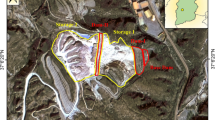Abstract
In 2006, a cooperation project between China Geological Survey and the Geological Survey of Canada started the monitoring of the landslide along the deep-cut valley in the western Sichuan using integrated GPS and InSAR observation at the Jiaju landslide. Both GPS and InSAR techniques provided complementary measurements with the GPS providing horizontal movement and InSAR providing vertical motion. Meanwhile, InSAR images demonstrate also an effective tool to recognize new landslides in complex steep mountain region. The GPS observations provide continuous monitoring data while InSAR data provide monthly measurements. The differential InSAR results show a deformation information that divided the Jiaju landslide to two areas, the north and south parts. The north part is sliding greater than the southern part in spatial domain. The sliding was faster in 2008 than that in 2006 in time domain, suggesting a gradual increased acceleration over time. The GPS displacement data during the past 2 years show the northern part slid horizontally 55–207 mm/a and vertically −23 mm/a, while the southern part slid horizontally 12–34 mm/a; and the vertical displacement mainly moved downward 0.05 to 12 mm/a. On average, the observations from December of 2006 to January of 2008 indicate that the northern part is sliding at 41.6 mm/a horizontally and 43.9 mm/a vertically, while the southern part is sliding at 16.1 mm/a horizontally and 17.5 mm/a vertically. The data acquired through the GPS and InSAR are generally comparable. Geological survey revealed some secondary landslides, cracks, and fissures within the deformation of the Jiaju landslide that could be induced by following factors: surface water drainage, river erosion, and slope cutting and overloading.





Similar content being viewed by others
References
CCRS (2006) The Landslide of Jiaju. Internal Document. pp 1–3
Chen Z, Shen F, Zhang X et al (1999) GPS monitoring of the crustal motion in Southwestern China. Chin Sci Bull 44:1804–1807
Singhroy V (2008) Satellite remote sensing applications for landslide detection and monitoring (chapter7). In: Sassa K, Canuti P (eds) Landslide disaster risk reduction. Springer, Berlin, pp 143–158
Singhroy V, Molch K, Couture R, Poncos V (2006) InSAR monitoring of post-landslide activity. In: IEEE International Geoscience and Remote Sensing Symposium. CO, USA, pp 1–4
Xia Y, Kaufmann H, Guo X (2002) Differential SAR interferometry using corner reflectors. In IEEE International Geoscience and Remote Sensing Symposium, Toronto, Canada. Vol.2, pp 1243–1246
YIN Y, LI T, TANG J (2008) Landslide reactivation and stabilization on Danba County in Sichuan Province. CJRME 27(5):971–978
Acknowledgment
This paper is the result of the cooperation project “InSAR monitoring, typical landslide as example” conducted by both CGS and GSC. We would like to specially thank Prof. Peter Bobrowsky, Singhroy Vern, Valentin Poncos, Pierre-Jean Alasset, Goran Pavlic, and Rejean Couture, who come from GSC for their help.
Author information
Authors and Affiliations
Corresponding author
Additional information
An erratum to this article can be found at http://dx.doi.org/10.1007/s10346-010-0232-x
Rights and permissions
About this article
Cite this article
Yin, Y., Zheng, W., Liu, Y. et al. Integration of GPS with InSAR to monitoring of the Jiaju landslide in Sichuan, China. Landslides 7, 359–365 (2010). https://doi.org/10.1007/s10346-010-0225-9
Received:
Accepted:
Published:
Issue Date:
DOI: https://doi.org/10.1007/s10346-010-0225-9




